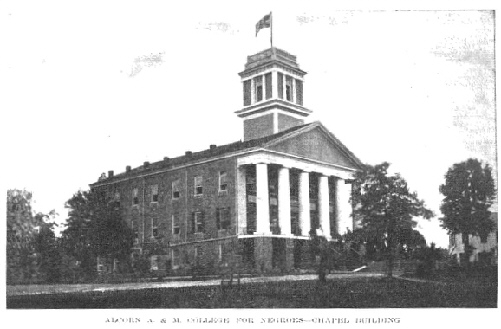.
Alcorn

ALCORN COUNTY
Chapter XLIV, pages 683-684
Situated in the northeastern corner of
the State, in the first tier of northern counties, Alcorn is one of the
comparatively modern political divisions of Mississippi. It was erected
April 15, 1870, from Tippah and Tishomingo counties, and named in honor
of Gov. James L. Alcorn, the first chief executive of the State chosen
under the constitution of 1869.
Corinth is the county seat and is a prosperous
city of about 6,000 people, advantageously located at the junction of the
Southern, Mobile & Ohio and Illinois Central railways. It has an interesting
history connected with the days of the Confederacy, as has all the region
surrounding it, a full account of which may be found in the chapters on
the War for Southern Independence. With the exception of Columbus, it is
the only large manufacturing point in the northern portion of the State,
a section chiefly supplied by Memphis. In 1920 Alcorn County had sixty
industrial establishments of all kinds, paying out over $400,000 in wages,
which were mostly situated in Corinth. There are no other large towns in
the county, the more important ones being Rienzi, the old rival of Corinth,
and the only incorporated town in the county outside of Corinth; Kossuth,
Jacinto, the first county seat of old Tishomingo County; Danville, an important
town in the early history of Tishomingo; and Wenasoga.
Alcorn County presents a diversified soil
lying partly in the Northeastern Prairie and partly in the Limestone Formation
belts. The former region, comprising the larger portion of the county,
is characterized by a heavy, calcareous, clay soil, very fertile and capable
of producing a great variety of products; the latter region, due to the
presence of iron, often presents a soil of a deep red color, while in other
places it is quite sandy, and in still other sections it is deeply impregnated
with lime. Some of the soil in this section is very fertile, while some
is only moderately productive.
The general surface of the county is gently
rolling prairie, mostly timbered, interspersed with level prairie tracts
and hilly oak uplands and a considerable area of rich river and creek bottoms.
It is possessed of excellent soil, well watered by the Hatchie and Tuscumbia
rivers, and more than a dozen small creeks. It is well timbered with pine,
poplar, white, red, post and black oak, hickory, ash, gum and sassafras.
Good churches and schools are to be found in every township, and excellent
transportation
facilities are afforded by the three lines of railway above mentioned.

Although a young county, Alcorn has a
population of 21,369. It has nearly doubled since 1870, its most pronounced
growth having taken place since 1910, when it had a population of about
18,000. This has been largely caused by the development of Corinth as an
industrial center, and the fact that the county has progressed agriculturally
and has a good future in that regard. Most of the farmers are white, only
about 400 of the 3,000 agriculturists being negroes. The crops of cereals
and other grains, hay and forage, vegetables, fruits and nuts, cotton and
other "miscellaneous products," which are bringing wealth and contentment
to the farmers of Alcorn County, are valued at $3,325,000. Of this sum,
the cereals brought in nearly one-third. Of the leader, corn, more than
543,000 bushels were raised. Cotton occupied 23,499 acres and its fields
yielded 7,920 bales in 1919.
The standing of Alcorn County as a producer
of live stock is pronounced, as the value of her domestic animals is $1,269,000.
In this class, dairy cattle stand well to the front, being valued at $287,000.
Mules lead, with a valuation of $598,000. It is also well adapted to raise
horses, those in the county being valued at $225,000.
Return to County History
Index
MSGenWeb Home
Source:
Mississippi The Heart of the South - By Dunbar Rowland, LL.D - Director
of the Mississippi State Department of Archives and History. Vol.
II Illustrated. Chicago-Jackson; The S. J. Clarke Publishing
Company, 1925. Public Domain
Copyright Notice: All files
and photographs on this site are copyrighted by their creator and/or contributor,
unless otherwise noted. They may be linked to but may not be reproduced
on another site without specific permission from The MSGenWeb State Coordinator
or the Assistant State Coordinator, and/or their contributor. Although
public information is not in and of itself copyrightable, the format in
which they are presented, the notes and comments, etc., are. It is however,
quite permissible to print or save the files to a personal computer for
personal use ONLY.
  
|





